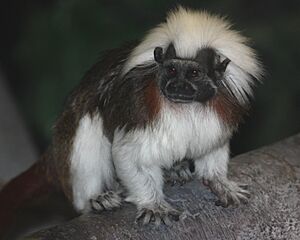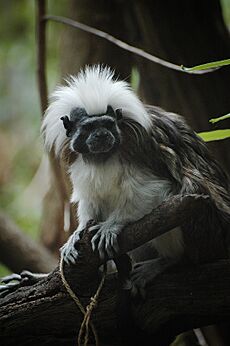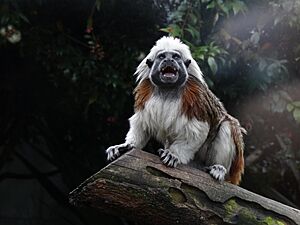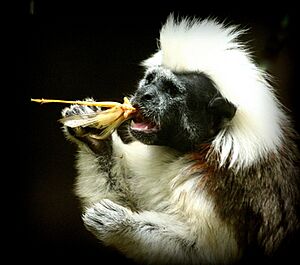Cotton-top tamarin facts for kids
Quick facts for kids Cotton-top tamarin |
|
|---|---|
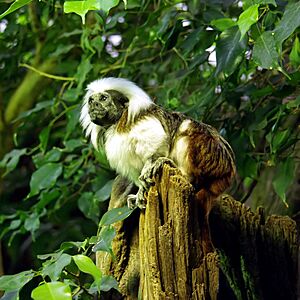 |
|
| The cotton-top tamarin | |
| Conservation status | |
| Scientific classification | |
| Genus: |
Saguinus
|
| Species: |
oedipus
|
 |
|
| Range of the Cotton-top Tamarin | |
| Synonyms | |
|
|
The cotton-top tamarin (Saguinus oedipus) is a small New World monkey. It weighs less than 0.5 kg (1.1 lb). This tiny monkey can live up to 24 years in zoos. In the wild, most live about 13 years. It is one of the smallest primates. You can easily spot it by its long, white hair. This hair looks like a crest from its forehead to its shoulders.
Cotton-top tamarins live in tropical forests in northwestern Colombia. They prefer forest edges and secondary forests. These monkeys live in trees (arboreal) and are active during the day (diurnal). They eat insects and plant sap. They also help spread seeds in the forest.
These tamarins have many interesting social behaviors. Groups have a clear leader pair. Only this dominant pair usually has babies. The female often gives birth to twins. She uses special smells (pheromones) to stop other females from breeding. Scientists have studied these tamarins a lot. They show strong cooperative care. They also show helpful (altruistic) and sometimes even mean (spiteful) behaviors. They communicate in a complex way. Their calls even show simple grammatical structure.
Before 1976, many cotton-top tamarins were caught. Up to 40,000 were taken for biomedical research. Then, CITES gave them the highest protection. This stopped all international trade. Now, their biggest threat is habitat destruction. The forests where they live in Colombia have shrunk a lot. Only 5% of their original forest is left. The cotton-top tamarin is now critically endangered. It is one of the rarest primates. Only about 6,000 are left in the wild.
Contents
About the Cotton-top Tamarin
The cotton-top tamarin is also called the "cotton-headed tamarin." Its name comes from the white hair on its head. This hair looks like a cotton puff. In Spanish, people call it bichichi or tití leoncito. In German, it's known as Lisztaffe. This means "Liszt monkey." It's named after the composer Franz Liszt. His hair looked similar to the tamarin's crest.
The famous scientist Carl Linnaeus first described this species in 1758. He named it Simia oedipus. The name oedipus means "swollen foot." But these monkeys don't have big feet. Linnaeus often picked names from old myths.
What They Look Like
The cotton-top tamarin is part of the smallest monkey family, Callitrichidae. This family includes marmosets and tamarins. An adult cotton-top tamarin weighs about 432 g (15.2 oz). Its body is about 20.8–25.9 cm (8.2–10.2 in) long. Its tail is a bit longer, around 33–41 cm (13–16 in). The tail cannot grab things. Males and females are about the same size.
These monkeys have sharp claws (tegulae) on all fingers and toes. Only their big toes have flat nails like humans. These claws help them climb trees like squirrels. The cotton-top tamarin has a long, white crest of hair. This hair goes from its forehead over its shoulders. Its face is black. It has gray or white stripes above its eyes. These stripes go down to its jaw.
Cotton-top tamarins have fine white hair on their faces. But it's so fine that their faces look bare. Their lower canine teeth are longer than their front teeth. They look a bit like small tusks. Like other tamarins, they have two molar teeth on each side of their jaw. Most other New World monkeys have three.
Their back is brown. Their belly, arms, and legs are yellowish-white. Their rump and upper tail are reddish-orange. Some tamarins have striking stripes or swirls of fur on their throats. They also have whiskers on their forehead and around their mouth.
Where They Live

The cotton-top tamarin lives only in a small part of northwest Colombia. This area is between the Cauca and Magdalena Rivers. It stretches to the Atlantic coast in the north. The Atrato River is to the west. Sadly, 98% of their habitat has been destroyed.
Historically, they lived all over this area. But now, they only survive in small, separated parks and reserves. One important place for them is Paramillo National Park. This park has 460,000 hectares (1,800 sq mi) of forests.
Cotton-top tamarins live in both old (primary) and new (secondary forest) forests. They can be found in humid tropical forests in the south. They also live in dry tropical forests in the north. They usually stay below 400 m (1,300 ft) in height. But sometimes they are seen as high as 1,500 m (4,900 ft). They prefer the lower parts of the forest. They also look for food on the ground. They can live in disturbed areas. In dry forests, there are clear wet and dry seasons. Heavy rain falls from August to November.
What They Eat
Cotton-top tamarins mainly eat fruit (40%) and insects (40%). They also eat plant sap, nectar, and sometimes small reptiles or amphibians. Because they are small and digest food quickly, they need high-energy food. They hunt insects in many ways. They might sneak up, pounce, chase, or turn over leaves.
Tamarins help spread seeds in the forest. They eat smaller seeds. The seeds they pass grow better than others. Eating larger seeds might also help them get rid of gut parasites.
These tamarins are active during the day. They sleep in trees with their group. They leave their sleeping tree about an hour after sunrise. They spend the day looking for food, resting, traveling, and grooming. They tend to wake up late. Then they speed up their search for food before dark. This helps them avoid predators that are active at dawn or dusk. Their main predators are raptors (like hawks), mustelids (like weasels), felids (like small wild cats), and snakes.
Cotton-top tamarins are very watchful. One monkey often acts as a lookout while the others rest. This lookout alerts the group if there is danger. In zoos, they can live up to 24 years. In the wild, they live about 13 years.
How They Behave
Social Life
Cotton-top tamarins are very social animals. They usually live in groups of two to nine monkeys. Sometimes groups can have up to 13 members. These family groups change in size and who is in them. There is always a clear leader pair. This pair is usually the only one that has babies. They are often monogamous, meaning they stay together. The female leader is usually in charge of the male.
Other group members can be the leader pair's children. Or they can be adult tamarins who have joined the group. These groups help each other. Scientists think this social setup helps protect them from predators. Cotton-top tamarins show helpful behaviors. They are known for cooperative breeding. This means the other adults in the group help raise the babies of the dominant pair. The dominant female often has non-identical twins. It would be too much work for just the parents to raise them.
The dominant female uses special smells (pheromones) to stop younger females from breeding. This delays their growth into adults. If unrelated males join the group, this control can sometimes be broken. Then, more than one female might get pregnant. But usually, only one pregnancy is successful.
Helping Each Other
In cooperative breeding, everyone in the group helps care for the babies. Parents, siblings, and other adults share the duties. These duties include carrying, protecting, feeding, comforting, and playing with the young. Cotton-top tamarins put a lot of effort into caring for their babies. Males, especially the fathers, help more than females. But both male and female babies prefer to be close to their mothers.
Males might help more to impress the dominant female. However, studies show that carrying babies doesn't mean a male will mate more often. Since only one female breeds, everyone helps to make sure all babies survive. Carrying babies can be very tiring for males. They might lose 10–11% of their body weight. This can happen because carrying babies makes it harder to find food. But the dominant female gains weight when she is ready to have more babies. She also does less baby-carrying then.
Sometimes, tamarins help others for their own benefit. For example, males helping with babies might lead to more babies with their genes. Also, how much they help can change. First-time fathers carry babies more than experienced ones. In smaller groups, fathers do more carrying and feeding. In larger groups, other helpers do more. The total care for babies stays the same no matter the group size.
Cotton-top tamarins are expected to be helpful due to their cooperative breeding. They help by caring for babies, making alarm calls, and sharing food. Some studies suggest they can remember who helps them. They use this to decide who to cooperate with later. If a monkey doesn't cooperate, it can quickly break trust. So, tamarins might make choices based on who they think will help them back.
Spite and Aggression
Even though they are helpful, cotton-top tamarins can also be mean. They might stop cooperating with monkeys who don't help them. In zoos, they don't seem to become more helpful to those who always cooperate. This suggests they might punish others. This behavior is seen in other animals too.
Cotton-top tamarins can be aggressive within their groups. They are often aggressive towards monkeys of the same gender. Females are more aggressive than males. This aggression is important when a breeding female forces younger females to leave the group.
When facing intruders from other species, their reaction is stronger. Females often use scent-marking to show threats. Males are more likely to make loud threats, act physically aggressive, and puff up their fur. Females use two ways to scent-mark: anogenital and suprapubic scent-marking. These different signals might be used for territorial fights or breeding signals. Females are equally threatening to male or female intruders. Males are much more threatening to other males than to females.
Talking Tamarins
Cotton-top tamarins make bird-like whistles, soft chirps, high-pitched trills, and short, sharp calls. Scientists say they have 38 different sounds. These sounds are very complex and follow rules like a language. Researchers found they use eight types of short "chirps." Each chirp means something different. They also use five longer "whistles." Some of their calls show they use phonetic syntax. This means they combine sounds to make words. Other calls might show lexical syntax. This means they use specific "words" for specific things. For example, C-calls are for finding food. D-calls are for eating. They can change their calls to help others find where the sound came from. Adults can use these calls to share intentions, thoughts, and feelings. These include curiosity, fear, joy, and warnings.
Learning to Talk
When a cotton-top tamarin baby is born, it can't make all the sounds an adult can. But scientists think they learn to understand sounds first. Then they learn to make them. Babies sometimes make adult-like chirps. But they don't use them correctly. Still, baby tamarins can react properly to adult chirps. This shows they learn to understand sounds quickly. Making the right sounds comes later.
Babies often make a special "prototype chirp." This chirp is different from any adult sound. Babies seem to copy adults. Adults use different calls in different situations. But babies use only their prototype chirp. For example, adults make fewer alarm calls when babies are around. This might be to avoid attracting predators to the babies. Babies also chirp less when predators are near. It's not clear if babies are just copying adults or if they understand the danger. But scientists believe young tamarins understand what sounds mean, even if they can't make all the adult sounds yet.
To prove this, researchers showed that babies react to adult calls in ways that show understanding. When an adult makes a C-call (for finding food), a baby will go to the adult to be fed. But the baby doesn't use its prototype chirp as a C-call. This means babies understand the calls first. They learn to use adult calls later.
Different Calls
Two important calls are the combination long call (CLC) and the alarm call (AC). CLCs are used when a monkey is alone. They combine chirps and whistles. This call is also used as an alarm call. It's made when a predator is seen near family members. Predators include snakes, ocelots, tayras, and especially hawks. Early studies showed that cotton-tops make different alarm calls for birds of prey versus ground predators.
CLCs are complex calls with many parts. Scientists believe these long calls are unique to each monkey. This means other tamarins can tell who is calling. Studies have confirmed this. But individual parts of the call don't carry enough information alone. The whole call is needed to understand the message. This suggests cotton-tops use a kind of "word" system in their communication.
Since tamarins can tell different predators apart by their calls, they get a lot of information from alarm calls. They can tell who is calling. They can also tell the gender of the caller. This helps them judge how reliable the alarm is. It also helps them figure out the danger level.
Being able to locate sounds helps them find predators. Especially if another tamarin makes a second alarm call. This helps confirm the predator's presence and type (flying or on the ground). It also helps them figure out the predator's exact location. In their cooperative groups, this helps them know which family members are in danger. For example, they can tell if babies, mates, or other relatives are at risk. Then they can plan what to do.
Food Calls
Cotton-top tamarins make special calls when they find food. The C-call is made when they approach and sort through food. The D-call is used when they get food and while eating.
C-calls are thought to show how much they like a food. A tamarin will make C-calls more often and faster for food it really likes. This might tell other tamarins what the caller is doing. It also tells them if good food is available. But some studies show that how much food there is, or who is listening, doesn't change the calls much.
Cotton-top tamarins make food calls even if no other group members are around. They also respond to food calls without seeing the food source. This suggests that food calls give other tamarins real information about the food.
Protecting Them
There are only about 6,000 cotton-top tamarins left in the wild. About 2,000 of these are adults. This species is critically endangered. It was listed in "The World's 25 Most Endangered Primates" from 2008 to 2012. This list is published by the International Union for Conservation of Nature.
The main reason for their decline is deforestation. They have lost more than three-quarters of their original home. The lowland forest where they live is now only 5% of its past size. This land is used for farming, logging, oil palm plantations, and hydroelectric projects. These activities break up the tamarin's natural habitat.
The illegal pet trade and scientific research have also caused problems. While scientists now use fewer tamarins, illegal capture for pets is still a big threat. Before 1976, many cotton-top tamarins were caught. They were exported for research into diseases like colitis and colon cancer. They were also studied for the Epstein–Barr virus. Now, international law protects the species. Even though there are enough tamarins in zoos to keep the species going, they are still critically endangered in the wild.
Proyecto Tití ("Project Tamarin") started in 1985. It works to protect the cotton-top tamarin and its home in Colombia. Proyecto Tití runs research, education, and community programs. They spread awareness about this endangered species. They also encourage people to help protect it. They are now partners with the Wildlife Conservation Network.
See also
In Spanish: Mono Tití cabeciblanco para niños





